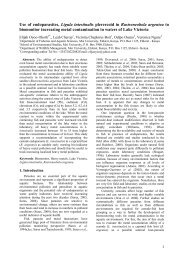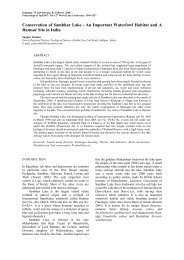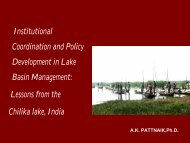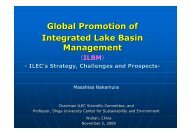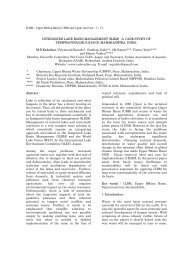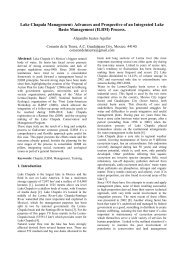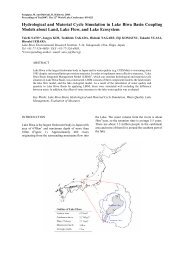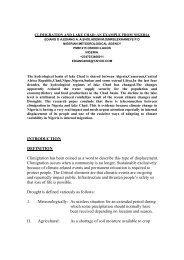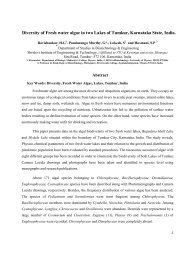Management of Haors, Baors, and Beels in Bangladesh Lessons for ...
Management of Haors, Baors, and Beels in Bangladesh Lessons for ...
Management of Haors, Baors, and Beels in Bangladesh Lessons for ...
You also want an ePaper? Increase the reach of your titles
YUMPU automatically turns print PDFs into web optimized ePapers that Google loves.
<strong>Management</strong> <strong>of</strong> <strong>Haors</strong>, <strong>Baors</strong>, <strong>and</strong> <strong>Beels</strong> <strong>in</strong><br />
<strong>Bangladesh</strong><br />
<strong>Lessons</strong> <strong>for</strong> Lake Bas<strong>in</strong> <strong>Management</strong><br />
Tapas Ranjan Chakraborty<br />
<strong>Bangladesh</strong> possesses enormous area <strong>of</strong> wetl<strong>and</strong>s <strong>in</strong>clud<strong>in</strong>g<br />
rivers <strong>and</strong> streams, freshwater lakes <strong>and</strong> marshes,<br />
haors, baors, beels, water storage reservoirs, fish ponds,<br />
flooded cultivated fields <strong>and</strong> estuar<strong>in</strong>e systems with extensive<br />
mangrove swamps. The haors, baors, beels <strong>and</strong> jheels<br />
are <strong>of</strong> fluvial orig<strong>in</strong> <strong>and</strong> are commonly identified as freshwater<br />
wetl<strong>and</strong>s. These freshwater wetl<strong>and</strong>s occupy four<br />
l<strong>and</strong>scape units - floodpla<strong>in</strong>s, freshwater marshes, lakes<br />
<strong>and</strong> swamp <strong>for</strong>ests. <strong>Bangladesh</strong> is estimated to possess<br />
seven to eight million hectares <strong>of</strong> wetl<strong>and</strong>s <strong>in</strong> the <strong>for</strong>m <strong>of</strong><br />
permanent rivers <strong>and</strong> streams (480,000 hectares), estuar<strong>in</strong>e<br />
<strong>and</strong> mangrove swamps (610,000 hectares), shallow lakes<br />
<strong>and</strong> marshes (120 000-290 000 ha), large reservoirs (90,000<br />
ha), small ponds <strong>and</strong> tanks (150 000-180 000 ha), shrimp<br />
ponds (90000-115000 ha) <strong>and</strong> seasonally flooded flood<br />
pla<strong>in</strong>s (5,770,000 hectares) (Nishat, 1993).<br />
<strong>Haors</strong>, which are bowl-shaped depressions between the<br />
natural levees <strong>of</strong> a river subject to monsoon flood<strong>in</strong>g every<br />
year, are mostly found <strong>in</strong> the eastern region <strong>of</strong> the country,<br />
known collectively as Haor bas<strong>in</strong> cover<strong>in</strong>g an area <strong>of</strong><br />
approximately 24,500 km 2 . There are altogether 411 haors<br />
compris<strong>in</strong>g an area <strong>of</strong> about 8000 km 2 dispersed <strong>in</strong> the<br />
districts <strong>of</strong> Sunamgonj, Sylhet, Moulvibazar, Hobigonj,<br />
Netrokona & Kishoreganj.<br />
<strong>Beels</strong> are large surface waterbodies that accumulate surface<br />
run<strong>of</strong>f water through <strong>in</strong>ternal dra<strong>in</strong>age channels; these<br />
depressions are mostly topographic lows produced by<br />
erosions <strong>and</strong> are seen all over <strong>Bangladesh</strong>. <strong>Beels</strong> are small<br />
saucer-like depressions <strong>of</strong> a marshy character. Many <strong>of</strong><br />
the beels dry up <strong>in</strong> the w<strong>in</strong>ter but dur<strong>in</strong>g the ra<strong>in</strong>s exp<strong>and</strong><br />
<strong>in</strong>to broad <strong>and</strong> shallow sheets <strong>of</strong> water, which may be<br />
described as fresh water lagoons. In the active floodpla<strong>in</strong>s<br />
<strong>of</strong> the Surma-Meghna, the Brahmaputra-Jamuna, <strong>and</strong> the<br />
Ganges-Padma river systems, there are several large <strong>and</strong><br />
small beels. In <strong>Bangladesh</strong>, there are thous<strong>and</strong>s <strong>of</strong> beels <strong>of</strong><br />
different sizes. Some <strong>of</strong> the most common names are Chalan<br />
beel, Ch<strong>and</strong> Beel <strong>and</strong> Arial beel. Most <strong>of</strong> these large beels<br />
have shrunk quite considerably <strong>in</strong> recent decades. <strong>Beels</strong> are<br />
ma<strong>in</strong>ly fed by surface run<strong>of</strong>f water. A few larger ones are<br />
fed by floodwater dur<strong>in</strong>g the wet season from the parent<br />
river channel. Normally, beels rema<strong>in</strong> deeply flooded <strong>for</strong><br />
most <strong>of</strong> the wet season.<br />
<strong>Baors</strong> are oxbow lakes, <strong>for</strong>med by dead arms <strong>of</strong> rivers, are<br />
situated <strong>in</strong> the moribund delta <strong>of</strong> the Ganges <strong>in</strong> western<br />
part <strong>of</strong> the country. In <strong>Bangladesh</strong>, oxbow lakes are quite<br />
visible <strong>in</strong> the older floodpla<strong>in</strong>s. Locally, the feature is also<br />
known as beel, baor, <strong>and</strong> jheel. Usually, oxbow lakes are<br />
deeply flooded dur<strong>in</strong>g the monsoon, either through local<br />
ra<strong>in</strong>fall <strong>and</strong> run<strong>of</strong>f water or by river flood. Dur<strong>in</strong>g the monsoon<br />
season oxbow lakes act as local water reservoirs, <strong>and</strong><br />
help to control the local flood level. In some areas, these<br />
lakes serve as valuable sources <strong>of</strong> irrigation dur<strong>in</strong>g the dry<br />
season.<br />
The Haor, <strong>Baors</strong> <strong>and</strong> <strong>Beels</strong> play an important role <strong>in</strong> the<br />
ecology, economy <strong>and</strong> livelihood <strong>of</strong> the country. Those<br />
wetl<strong>and</strong>s have been highly explored <strong>for</strong> a long time; dur<strong>in</strong>g<br />
the 1990s the nation realized the needs <strong>of</strong> resource<br />
management seriously <strong>and</strong> from then the management <strong>and</strong><br />
conservation <strong>of</strong> those water bodies got priority. Though the<br />
status <strong>of</strong> nations wetl<strong>and</strong> management <strong>in</strong>itiatives are not <strong>in</strong><br />
satisfactory level but <strong>in</strong> some cases the success is appraisable<br />
<strong>and</strong> can be followed <strong>for</strong> management <strong>of</strong> different lake<br />
bas<strong>in</strong>s consider<strong>in</strong>g the socio-economic <strong>and</strong> ecological contest<br />
<strong>and</strong> with adaptation if necessary.<br />
Wetl<strong>and</strong> resources:<br />
The life <strong>and</strong> livelihood on <strong>Bangladesh</strong> is dependent on the<br />
wetl<strong>and</strong>s. The lakes are the source <strong>of</strong> fisheries, aquatic vegetations<br />
<strong>and</strong> other biodiversity, irrigation, navigation <strong>and</strong><br />
flood control etc.<br />
Fisheries resources<br />
About 260 species <strong>of</strong> freshwater fishes are found <strong>in</strong> the<br />
<strong>in</strong>l<strong>and</strong> water bodies <strong>of</strong> <strong>Bangladesh</strong>. Inl<strong>and</strong> fisheries alone<br />
cover an area <strong>of</strong> 4.3 million hectares <strong>of</strong> which 94% comprise<br />
openwater capture fisheries, <strong>and</strong> only 6% close water system.<br />
The haors, beels <strong>and</strong> baors <strong>of</strong>fer tremendous scope<br />
<strong>and</strong> potential to augment fish production by adoption <strong>of</strong><br />
culture-based fishery enhancement technique. Sixty three<br />
species <strong>of</strong> fishes were recorded from the water bodies <strong>of</strong><br />
Ch<strong>and</strong>a Beel. (Chakraborty et.al., 2005). The haors, beels<br />
<strong>and</strong> baors are the ma<strong>in</strong> source <strong>and</strong> reserves <strong>of</strong> the brood<br />
stock <strong>of</strong> fish. Tangua is one <strong>of</strong> the famous breed<strong>in</strong>g ground<br />
<strong>for</strong> native crabs <strong>and</strong> flat fishes (Chital) <strong>of</strong> the country.
Biodiversity<br />
Not only the aquatic biodiversity <strong>in</strong>clud<strong>in</strong>g, fish, snails,<br />
turtle etc., but many <strong>of</strong> the lakes that dried partly <strong>in</strong> the l<strong>in</strong>e<br />
season supports different types <strong>of</strong> terrestrial <strong>and</strong> aquatic<br />
vegetations. Around 400 species <strong>of</strong> migratory birds visited<br />
<strong>Bangladesh</strong>. Tangur Haor is an important Ramsar site.<br />
Huge number <strong>of</strong> migratory birds visited Hakaluki Haor,<br />
Hail Haor, Ramsagar, etc. One hundred sixty three species<br />
<strong>of</strong> wildlife were recorded found <strong>and</strong> or depended on<br />
the Ch<strong>and</strong>a beel, among them 7 were amphibian, 21 were<br />
reptalia, 111 were birds <strong>and</strong> 19 were mammal (Chakraborty<br />
et. al., 2005); among the birds 19 were recorded migratory.<br />
Seven species <strong>of</strong> snails are found <strong>in</strong> Ch<strong>and</strong>a beel among<br />
them 2 has commercial importance (Khan et. al., 2005).<br />
Agriculture<br />
The rims <strong>of</strong> the lakes are used <strong>for</strong> w<strong>in</strong>ter (boro) rice cultivation.<br />
The flooded fields <strong>in</strong> the monsoon became rich with<br />
m<strong>in</strong>erals <strong>and</strong> are very fertile. There are also deepwater rice<br />
verities. The deepwater rice has submergence toleration<br />
<strong>and</strong> elongation ability. At one time, undivided Bengal had<br />
about 15,000 varieties <strong>of</strong> cultivated rice but the germplasum<br />
<strong>of</strong> most <strong>of</strong> them is lost leav<strong>in</strong>g only about 6,000 (Khan et. al.<br />
1994). Lakes are the source <strong>of</strong> irrigation <strong>in</strong> w<strong>in</strong>ter. Almost<br />
every non-rice crops <strong>in</strong> <strong>Bangladesh</strong> grow <strong>in</strong> w<strong>in</strong>ter.<br />
Flood control<br />
<strong>Bangladesh</strong> is a low ly<strong>in</strong>g area. Because <strong>of</strong> its location,<br />
water <strong>of</strong> the Ganga-Bramaputa catchments flows through<br />
<strong>Bangladesh</strong>. The lakes act as natural reserves <strong>of</strong> the water.<br />
Threats to the Lakes <strong>of</strong> <strong>Bangladesh</strong><br />
All most every lake <strong>of</strong> <strong>Bangladesh</strong> is under threat. There<br />
is huge population pressure, climate change impact <strong>and</strong><br />
development <strong>in</strong>teractions. The follow<strong>in</strong>g are the major<br />
threats to the lakes <strong>of</strong> <strong>Bangladesh</strong>:<br />
1. Disappear<strong>in</strong>g<br />
2. Pollution<br />
3. Over harvest<strong>in</strong>g <strong>of</strong> the natural resources<br />
4. L<strong>and</strong> use conflict<br />
5. Lack <strong>of</strong> up stream water flow <strong>in</strong> w<strong>in</strong>ter<br />
6. Over flow <strong>of</strong> water <strong>in</strong> monsoon<br />
7. Increase risk <strong>of</strong> flood<br />
8. Entrance <strong>of</strong> sal<strong>in</strong>e water due to lack <strong>of</strong> water flow <strong>in</strong><br />
w<strong>in</strong>ter<br />
9. L<strong>and</strong> erosion<br />
10. Siltation<br />
11. Road construction <strong>and</strong> other development activities<br />
Institutions <strong>in</strong>volved <strong>in</strong> Lake <strong>Management</strong> <strong>in</strong><br />
<strong>Bangladesh</strong><br />
<strong>Bangladesh</strong> Water Development Board is the ma<strong>in</strong> government-body<br />
to manage the lakes. <strong>Bangladesh</strong> Water<br />
Development Board (BWDB) started its operation <strong>in</strong> 1959<br />
as the water w<strong>in</strong>g <strong>of</strong> the erstwhile East Pakistan Water <strong>and</strong><br />
Power Development Authority. As the pr<strong>in</strong>cipal agency<br />
<strong>of</strong> the government <strong>for</strong> manag<strong>in</strong>g water resources <strong>of</strong> the<br />
country, it was given the responsibility <strong>of</strong> accomplish<strong>in</strong>g<br />
the tasks <strong>of</strong> execut<strong>in</strong>g flood control, dra<strong>in</strong>age <strong>and</strong> irrigation<br />
projects to boost up productivity <strong>in</strong> agriculture <strong>and</strong> fisheries.<br />
After the <strong>in</strong>dependence <strong>of</strong> <strong>Bangladesh</strong>, the authority<br />
was restructured <strong>in</strong> 1972 <strong>in</strong>to two different organizations<br />
to deal with water <strong>and</strong> power separately. BWDB was created<br />
under the <strong>Bangladesh</strong> Water <strong>and</strong> Power Development<br />
Boards Order 1972 (P.O. No. 59 <strong>of</strong> 1972) as a fully autonomous<br />
organization. The re<strong>for</strong>m program <strong>and</strong> structural<br />
adjustment process were undertaken by the GoB <strong>for</strong><br />
trans<strong>for</strong>mation <strong>of</strong> BWDB is the enactment <strong>of</strong> the BWDB<br />
Act, 2000 that requires the BWDB’s functions be guided<br />
by the National Water Policy (NWPo) <strong>and</strong> National Water<br />
<strong>Management</strong> Plan (NWMP). Top management <strong>of</strong> BWDB is<br />
now vested <strong>in</strong> a policy <strong>and</strong> oversight Govern<strong>in</strong>g Council<br />
(GC) with thirteen Members headed by the M<strong>in</strong>ister,<br />
M<strong>in</strong>istry <strong>of</strong> water Resources.<br />
WARPO<br />
Beside this other government agencies like the Department<br />
<strong>of</strong> Environment <strong>and</strong> the Department <strong>of</strong> Fisheries is also<br />
responsible <strong>for</strong> the management <strong>of</strong> environment <strong>and</strong> fisheries<br />
resource <strong>of</strong> the lakes respectively. These above mentioned<br />
departments are under the M<strong>in</strong>istry <strong>of</strong> Environment<br />
<strong>and</strong> Forestry, <strong>and</strong> M<strong>in</strong>istry <strong>of</strong> Fisheries <strong>and</strong> Livestock<br />
respectively. For most <strong>of</strong> the Lake the l<strong>and</strong> rights are under<br />
the M<strong>in</strong>istry <strong>of</strong> L<strong>and</strong>. There are also other actors from<br />
Government work<strong>in</strong>g <strong>for</strong> Lakes, like Local Government<br />
Eng<strong>in</strong>eer<strong>in</strong>g Department, Space Research <strong>and</strong> Remote<br />
Sens<strong>in</strong>g Organization etc.<br />
A good number <strong>of</strong> Non Government Organizations are also<br />
work<strong>in</strong>g <strong>for</strong> the betterment <strong>of</strong> lakes. The activities <strong>of</strong> NGOs<br />
<strong>in</strong>cludes, flood control, natural resource conservation, livelihood<br />
development, farm<strong>in</strong>g <strong>and</strong> irrigation program, etc.<br />
Among these NGOs CNRS, IDEA, BCAS, AOSED, BRAC,<br />
Prosika, Nijera Kari, Samata, etc. are well-known.<br />
Legislation <strong>for</strong> lake management<br />
Although the exist<strong>in</strong>g laws <strong>in</strong> <strong>Bangladesh</strong> are not specific<br />
to the needs <strong>and</strong> problems <strong>of</strong> lake management <strong>and</strong><br />
2 <strong>Management</strong> <strong>of</strong> <strong>Haors</strong>, <strong>Baors</strong>, <strong>and</strong> <strong>Beels</strong> <strong>in</strong> <strong>Bangladesh</strong>
conservation, but there are some sectoral laws hav<strong>in</strong>g bear<strong>in</strong>g<br />
on lake issues. These are:<br />
1. The Haor Development Board Ord<strong>in</strong>ance, 1997<br />
2. <strong>Bangladesh</strong> Environmental Conservation Act 1995<br />
3. East Bengal Protection <strong>and</strong> Conservation <strong>of</strong> Fish Act,<br />
1950<br />
4. <strong>Bangladesh</strong> Wildlife (Preservation) (Amendment) Act,<br />
1974<br />
5. The East Bengal State Acquisition <strong>and</strong> Tenancy Act,<br />
1950<br />
6. The L<strong>and</strong> Re<strong>for</strong>m Board Act, 1989<br />
Beside the national Laws, <strong>Bangladesh</strong> is signatory <strong>of</strong><br />
Ramsar, CITES, CMS, etc.<br />
Projects<br />
The number <strong>of</strong> projects that have been implemented or ongo<strong>in</strong>g<br />
<strong>for</strong> the development <strong>of</strong> lakes <strong>and</strong> or lake resources is<br />
quite large. As <strong>for</strong> example BWDB has so far implemented<br />
about 617 projects / Sub-projects, Non-Government<br />
Organization CNRS has implemented 22 projects <strong>in</strong> <strong>and</strong><br />
<strong>for</strong> lake betterment. In <strong>Bangladesh</strong> <strong>in</strong> most <strong>of</strong> the cases the<br />
project activity ended by the completion <strong>of</strong> project period.<br />
But there are number <strong>of</strong> success stories. Some examples are<br />
bellow:<br />
Meghna-Dhonagoda Project by BWDB<br />
Atta<strong>in</strong><strong>in</strong>g self sufficiency <strong>in</strong> food production has been an<br />
un<strong>in</strong>terrupted objective <strong>of</strong> the development plann<strong>in</strong>g <strong>in</strong><br />
<strong>Bangladesh</strong>. So the ef<strong>for</strong>ts to elevate the productivity <strong>of</strong> her<br />
Agricultural sector to the possible optimum through application<br />
<strong>of</strong> modern technology is the ma<strong>in</strong> objective <strong>of</strong> the<br />
Government. <strong>Bangladesh</strong> Water Development Board under<br />
the M<strong>in</strong>istry <strong>of</strong> Water Resources has been <strong>in</strong>volved <strong>in</strong> such<br />
activities <strong>for</strong> long time.<br />
Dur<strong>in</strong>g 1964, M/S Pakistan Techno Consultant carried out<br />
a feasibility study <strong>of</strong> Meghna-Dhonagoda Irrigation Project.<br />
Dur<strong>in</strong>g 1977, after be<strong>in</strong>g requested by the Government <strong>of</strong><br />
People’s Republic <strong>of</strong> <strong>Bangladesh</strong>, M/S Chou-KaiHatsu <strong>of</strong><br />
Japan & Prakaushali Sangsad Ltd. <strong>of</strong> <strong>Bangladesh</strong> jo<strong>in</strong>tly<br />
prepared revised feasibility study report under f<strong>in</strong>ancial<br />
assistance from Asian Development Bank. ADB entered<br />
<strong>in</strong>to an agreement dur<strong>in</strong>g 1977 with Govt. <strong>of</strong> <strong>Bangladesh</strong><br />
<strong>for</strong> f<strong>in</strong>anc<strong>in</strong>g the execution <strong>of</strong> the project. The execution<br />
started <strong>in</strong> full sw<strong>in</strong>g dur<strong>in</strong>g 1979-80 <strong>and</strong> was completed<br />
1987-88. Under the Comm<strong>and</strong> Area Development (CAD)<br />
activities the follow<strong>in</strong>g were implemented:<br />
<strong>Lessons</strong> <strong>for</strong> Lake Bas<strong>in</strong> <strong>Management</strong><br />
• Rehabilitation<br />
• Water Users Organization <strong>for</strong>mation <strong>for</strong> water<br />
management<br />
• Involvement <strong>of</strong> Water User Group <strong>in</strong> cost recovery<br />
• Involvement <strong>of</strong> distress woman <strong>in</strong> embankment<br />
ma<strong>in</strong>tenance<br />
• Integrated Pest <strong>Management</strong><br />
• Small Scale Fisheries Development<br />
Community-Based Haor Resources <strong>Management</strong><br />
under Susta<strong>in</strong>able Environment <strong>Management</strong><br />
Program (SEMP 2.2.1/A) by CNRS<br />
Susta<strong>in</strong>able Environment <strong>Management</strong> Programme<br />
(SEMP) is the first follow-up activity <strong>in</strong> the implementation<br />
<strong>of</strong> NEMAP (National Environment <strong>Management</strong> Action<br />
Plan). It is be<strong>in</strong>g executed by the M<strong>in</strong>istry <strong>of</strong> Environment<br />
<strong>and</strong> Forest (MoEF) from October 1998 <strong>and</strong> was completed<br />
<strong>in</strong> December 2006. SEMP comprises <strong>of</strong> 26 components<br />
(<strong>in</strong>clud<strong>in</strong>g PMU - Programme <strong>Management</strong> Unit) <strong>for</strong> 25<br />
different projects <strong>and</strong> is be<strong>in</strong>g implemented by 21 Sub-<br />
Implement<strong>in</strong>g Agencies (SIAs) through a 26 million US dollars<br />
grant from UNDP. SEMP is the largest programme <strong>of</strong><br />
UNDP <strong>in</strong> <strong>Bangladesh</strong>. The objectives <strong>of</strong> SEMP are to build<br />
<strong>and</strong> strengthen capacity <strong>for</strong> environmental management at<br />
the Community (enable the poor to have access to environmental<br />
resources), Local (develop<strong>in</strong>g capacity to project the<br />
<strong>in</strong>terests <strong>of</strong> the poor), <strong>and</strong> National (suggest<strong>in</strong>g enactment<br />
<strong>of</strong> necessary <strong>and</strong> reduce exist<strong>in</strong>g laws, polices, etc.) levels.<br />
Along with these, SEMP also aims to prevent <strong>and</strong> reverse<br />
the present trend <strong>of</strong> environmental degradation, to promote<br />
susta<strong>in</strong>able development <strong>and</strong> reduce exist<strong>in</strong>g poverty<br />
<strong>and</strong> raise the quality <strong>of</strong> life. SEMP consists <strong>of</strong> five major<br />
sub-programmes: a) Policy <strong>and</strong> Institution; b) Participatory<br />
Ecosystem <strong>Management</strong>; 3) Community based environmental<br />
Sanitation; d) Awareness <strong>and</strong> Advocacy; <strong>and</strong> e) Tra<strong>in</strong><strong>in</strong>g<br />
<strong>and</strong> Education. Community based Haor <strong>and</strong> Floodpla<strong>in</strong><br />
Resource <strong>Management</strong> Projects under the broader theme <strong>of</strong><br />
participatory ecosystem management, <strong>of</strong>ficially compris<strong>in</strong>g<br />
SEMP Components 2.2.1/A <strong>and</strong> 2.2.1/B, have been implemented<br />
by IUCN, <strong>Bangladesh</strong> Country Office with support<br />
from the M<strong>in</strong>istry <strong>of</strong> Environment <strong>and</strong> Forests <strong>and</strong> United<br />
Nations Development Programme (UNDP) from1998 to<br />
2006. There were three national NGOs namely-<strong>Bangladesh</strong><br />
Center <strong>for</strong> Advance Studies (BCAS), Center <strong>for</strong> Natural<br />
Resource Studies (CNRS), <strong>and</strong> Nature Conservation<br />
<strong>Management</strong> (NECOM) have been associated <strong>for</strong> implement<strong>in</strong>g<br />
projects <strong>in</strong> five degraded Haor <strong>and</strong> Floodpla<strong>in</strong><br />
areas <strong>of</strong> the country. CNRS worked <strong>for</strong> Haor, NACOM <strong>and</strong><br />
BCAS worked <strong>for</strong> Padma-Jamuna, Brahmaputra-Stalakha<br />
floodpla<strong>in</strong>s; <strong>and</strong> the Madhumati floodpla<strong>in</strong>s respectively.<br />
3
The overall approach adopted <strong>for</strong> implementation <strong>of</strong> the<br />
project is shown <strong>in</strong> Figure 1.<br />
The project activities <strong>in</strong>clude Participatory plann<strong>in</strong>g, NR<br />
<strong>Management</strong> <strong>and</strong> awareness build<strong>in</strong>g organiz<strong>in</strong>g the users<br />
<strong>and</strong> stakeholders at local level, generate alternative livelihoods,<br />
disaster management (protect village mounds from<br />
wave action), disaster preparedness <strong>and</strong> cop<strong>in</strong>g mechanism.<br />
The community based fisheries management <strong>in</strong>clud<strong>in</strong>g<br />
fish sanctuary, swamp <strong>for</strong>est plantation, <strong>and</strong> green<br />
fund<strong>in</strong>g mechanism were developed under the project.<br />
The project has targeted to reverse the deteriorat<strong>in</strong>g tend<br />
<strong>of</strong> floodpla<strong>in</strong> ecology as well as to ensure the susta<strong>in</strong>able<br />
use <strong>of</strong> wetl<strong>and</strong> resources which <strong>in</strong>clude water, soil, ra<strong>in</strong>fall,<br />
fishes, wildlife <strong>and</strong> plants.<br />
<strong>Management</strong> <strong>of</strong> Aquatic Ecosystem through<br />
Community Husb<strong>and</strong>ry (MACH)<br />
Wetl<strong>and</strong>s <strong>of</strong> <strong>Bangladesh</strong> are rich <strong>in</strong> biodiversity <strong>and</strong> have<br />
great ecological, economic <strong>and</strong> social values <strong>in</strong> ensur<strong>in</strong>g<br />
livelihood security <strong>of</strong> millions <strong>of</strong> poor people particularly<br />
fisher community <strong>in</strong> <strong>Bangladesh</strong>. The wetl<strong>and</strong>s are under<br />
threat <strong>and</strong> gradually degrad<strong>in</strong>g due to several anthropogenic<br />
<strong>and</strong> natural causes. <strong>Management</strong> <strong>of</strong> Aquatic<br />
Ecosystem through Community Husb<strong>and</strong>ry (MACH) is a<br />
Figure 1. Overall approach <strong>for</strong> project implementation<br />
IUCN, 2004<br />
Government <strong>of</strong> <strong>Bangladesh</strong> project supported by USAID.<br />
MACH’s goal is the promotion <strong>of</strong> ecology sound management<br />
<strong>of</strong> floodpla<strong>in</strong> resources (fisheries <strong>and</strong> other wetl<strong>and</strong><br />
products) <strong>for</strong> the susta<strong>in</strong>able supply <strong>of</strong> food to the poor <strong>of</strong><br />
<strong>Bangladesh</strong>.<br />
The project has established community based co-management<br />
<strong>and</strong> helped restored <strong>and</strong> <strong>in</strong>crease susta<strong>in</strong>able productivity<br />
<strong>in</strong> three large wetl<strong>and</strong> ecosystems: Hail Haor <strong>in</strong><br />
Sreemongal, Turag-Bangshi River <strong>and</strong> wetl<strong>and</strong>s <strong>in</strong> Kaliakoir<br />
<strong>and</strong> the Kangsha-Malijee bas<strong>in</strong> <strong>in</strong> Sherpur. The project was<br />
implemented by W<strong>in</strong>rock International, USA, BCAS <strong>and</strong><br />
CARITAS, <strong>Bangladesh</strong>. The partners have worked closely<br />
with the department <strong>of</strong> fisheries s<strong>in</strong>ce 1989. The project<br />
<strong>in</strong>cluded realistic activity packages which covers household<br />
level livelihood plann<strong>in</strong>g <strong>and</strong> <strong>in</strong>tervention, tra<strong>in</strong><strong>in</strong>g<br />
needs assessment, awareness <strong>and</strong> <strong>in</strong>stitution build<strong>in</strong>g, habitat<br />
rehabilitation, af<strong>for</strong>estation, wise use <strong>of</strong> fish <strong>and</strong> other<br />
wetl<strong>and</strong> resources, establishment sanctuaries, community<br />
development & local level <strong>in</strong>stitution build<strong>in</strong>g <strong>and</strong> social<br />
<strong>and</strong> biological monitor<strong>in</strong>g.<br />
CBFM<br />
State owned waters <strong>in</strong> <strong>Bangladesh</strong> are usually managed<br />
under a commercial, revenue-focused leas<strong>in</strong>g system<br />
4 <strong>Management</strong> <strong>of</strong> <strong>Haors</strong>, <strong>Baors</strong>, <strong>and</strong> <strong>Beels</strong> <strong>in</strong> <strong>Bangladesh</strong>
controlled by the M<strong>in</strong>istry <strong>of</strong> L<strong>and</strong> (MOL). Poor fishers<br />
are effectively excluded from the best fisheries as they<br />
cannot af<strong>for</strong>d to pay <strong>for</strong> the lease. The Community Based<br />
Fisheries <strong>Management</strong> (CBFM) project implemented from<br />
1996 to 2006 by the <strong>in</strong>ternational research orgnization the<br />
WorldFish Center, <strong>in</strong> partnership with the Government <strong>of</strong><br />
<strong>Bangladesh</strong> Department <strong>of</strong> Fisheries (DoF) <strong>and</strong> local NGOs,<br />
<strong>in</strong> an action research project which has developed a series<br />
<strong>of</strong> community based fisheries management approaches<br />
(fisher-led, community-led <strong>and</strong> women led) <strong>for</strong> ensur<strong>in</strong>g<br />
equitable access to fisheries resources <strong>for</strong> community based<br />
management groups.<br />
Over a ten-year period, the CBFM project has established<br />
community control over 116 water bodies. Over 130 <strong>of</strong>ficially<br />
recognized, poverty-focused, Community Based<br />
Organizations (CBOs) are <strong>in</strong>volved <strong>in</strong> the management<br />
<strong>of</strong> these water bodies. However, <strong>in</strong> return <strong>for</strong> access, the<br />
CBOs must embrace the pr<strong>in</strong>cipals <strong>of</strong> susta<strong>in</strong>able fisheries<br />
management.<br />
One <strong>of</strong> the ma<strong>in</strong> actions <strong>of</strong> CBFM-2 has been to establish<br />
fish sanctuary-no fish<strong>in</strong>g zones where a proportion <strong>of</strong> the<br />
fish <strong>in</strong> the water body are allowed to stay safely even when<br />
surround<strong>in</strong>g water levels are at their lowest<br />
CWBMP<br />
In <strong>Bangladesh</strong> there are 8 Ecological Critical Areas (ECA).<br />
Those ECAs are mostly wetl<strong>and</strong>s, viz.<br />
1. Hakaluki Haor<br />
2. Cox’s Bazar Beach<br />
3. Sonadia Isl<strong>and</strong><br />
4. St. Mart<strong>in</strong>’s Isl<strong>and</strong><br />
5. Marjut Beel<br />
6. Gulshn-Baridhara Lake<br />
7. Tanguar Haor<br />
8. Periphery <strong>of</strong> Sundarbans<br />
The project Costal <strong>and</strong> wetl<strong>and</strong> Biodiversity <strong>Management</strong><br />
Project (CWBMP) aims to implement the ECA legislation<br />
through the participation <strong>of</strong> local community <strong>and</strong> alternative<br />
livelihood options. The project has been implemented<br />
s<strong>in</strong>ce 2006 <strong>in</strong> Hakaluki Haor, Cox’s Bazar Beach, Sonadia<br />
Isl<strong>and</strong> <strong>and</strong> St. Mart<strong>in</strong>’s Isl<strong>and</strong>. Village Conservation Groups<br />
(VCGs) <strong>for</strong>med <strong>for</strong> the objectives <strong>of</strong> the projects implement<strong>in</strong>g<br />
different activities <strong>in</strong>clud<strong>in</strong>g Alternative Income<br />
Generation, swamp plantation, mangrove plantation, n<strong>of</strong>ish<strong>in</strong>g<br />
zone, etc.<br />
<strong>Lessons</strong> <strong>for</strong> Lake Bas<strong>in</strong> <strong>Management</strong><br />
Tools used <strong>in</strong> wetl<strong>and</strong> development<br />
Through the implementation <strong>of</strong> different project <strong>and</strong> program<br />
different successful tools have been developed <strong>for</strong><br />
the conservation <strong>and</strong> management lakes, such as,<br />
• Participatory Action Plan Development<br />
• Community based Fisheries Resource <strong>Management</strong><br />
• Community based Fish sanctuary<br />
• Restoration <strong>of</strong> Swamp <strong>for</strong>est, etc.<br />
• Cultivation <strong>in</strong> Hydrophonic<br />
Participatory Action Plan Development (CNRS 2003)<br />
PAPD is a process, which can create an enabl<strong>in</strong>g environment<br />
among the community people to build their consensus.<br />
The process is so structured that by go<strong>in</strong>g through a<br />
series <strong>of</strong> steps, consensus could be built over what actions<br />
were needed to better manage natural resources, particularly<br />
common resources. In <strong>Bangladesh</strong> the practice <strong>of</strong> PAPD<br />
is highly appreciated to make community participat<strong>in</strong>g the<br />
management <strong>of</strong> wetl<strong>and</strong>s. PAPD was practiced successfully<br />
<strong>in</strong> management <strong>of</strong> Hail Haor, Hakaluki Haor, Arial Beel,<br />
etc. The PAPD method is described briefly <strong>in</strong> Annex I.<br />
Community based Fisheries Resource <strong>Management</strong><br />
Community based fisheries resource management is a<br />
community consensus where the community themselves<br />
develop some norms <strong>and</strong> practices <strong>for</strong> the betterment <strong>of</strong><br />
the fisheries resources as well as the security <strong>of</strong> their livelihood.<br />
The norm <strong>in</strong>cludes maximum size <strong>of</strong> nets, no fish<strong>in</strong>g<br />
periods, avoid<strong>in</strong>g harmful agricultural practices, etc.<br />
Community based fisheries resource management has<br />
been practiced <strong>in</strong> number <strong>of</strong> projects <strong>in</strong>clud<strong>in</strong>g CBFM-2<br />
<strong>in</strong> around 116 wetl<strong>and</strong>s over country (WorldFish Center).<br />
MACH project <strong>and</strong> ECFC project have also practiced the<br />
method. The method <strong>of</strong> community based fisheries resource<br />
management is briefly described <strong>in</strong> Annex II.<br />
Community based Fish Sanctuary<br />
Community based fisheries sanctuary has tremendous success<br />
stories. Resulted from the 4 th Fisheries, MACH Project<br />
<strong>and</strong> CBFMS to there are around hundreds community<br />
based fish sanctuaries <strong>in</strong> various sizes over the country. The<br />
community based fish sanctuary is community announced<br />
<strong>and</strong> practices project areas that is a no fish<strong>in</strong>g zone with<br />
a core area <strong>and</strong> a buffer zone. Community also facilitated<br />
some traditional techniques <strong>for</strong> the welfare <strong>of</strong> fish. Those<br />
sanctuaries are breed<strong>in</strong>g grounds <strong>and</strong> ensure the brood<br />
stock that <strong>in</strong>creases the fisheries resources. As an example<br />
<strong>of</strong> a Community based Fish Sanctuary the Baikka Beel is<br />
described <strong>in</strong> Annex III (CNRS 2007).<br />
5
BAIRA -Float<strong>in</strong>g Garden<br />
Baira is an <strong>in</strong>digenous practice <strong>of</strong> the farmers <strong>of</strong> Gopalganj,<br />
Barisal, Patuakhali etc southwest districts <strong>of</strong> <strong>Bangladesh</strong><br />
<strong>for</strong> cultivat<strong>in</strong>g seasonal vegetables <strong>and</strong> seedl<strong>in</strong>gs dur<strong>in</strong>g<br />
the monsoon. Water hyac<strong>in</strong>ths are congregated on the<br />
water to make flout<strong>in</strong>g organic plat<strong>for</strong>m the plat<strong>for</strong>m usually<br />
anchored <strong>in</strong> the convenient places <strong>of</strong> beel or canal. The<br />
surface <strong>of</strong> float<strong>in</strong>g plat<strong>for</strong>m once decomposed <strong>and</strong> seeds <strong>of</strong><br />
selected vegetables are placed <strong>in</strong> to a growth media prepared<br />
with the roots <strong>of</strong> submerged float<strong>in</strong>g vegetation.<br />
Growth media is then put on the plat<strong>for</strong>m <strong>for</strong> germ<strong>in</strong>ation<br />
<strong>and</strong> subsequent ris<strong>in</strong>g. S<strong>in</strong>ce the growth medium is organic<br />
the seedl<strong>in</strong>gs grow fast <strong>and</strong> usually the farmers sell the<br />
seedl<strong>in</strong>gs like cucumber, gourd, etc. <strong>in</strong> the local market.<br />
The seedl<strong>in</strong>gs are plans planted <strong>in</strong> the soil. Cultivation <strong>in</strong><br />
the biara is a means <strong>of</strong> earn<strong>in</strong>g money <strong>for</strong> cultivars dur<strong>in</strong>g<br />
monsoon when whole beel <strong>and</strong> its peripheries are <strong>in</strong>undated<br />
<strong>for</strong> about six moths <strong>of</strong> the year. There are 23 species<br />
<strong>of</strong> vegetables such as gourd, cucumber, eggplant, chili,<br />
sp<strong>in</strong>ach, ladies f<strong>in</strong>ger, lettuce, pumpk<strong>in</strong>, cauliflower, cabbage,<br />
etc., <strong>and</strong> 6 <strong>of</strong> spices such as z<strong>in</strong>ger, garlic, etc., that<br />
have been successfully produced <strong>and</strong> harvested on baira<br />
(Islam <strong>and</strong> Haque, 2002).The brief to baira preparation is<br />
described <strong>in</strong> Annex IV.<br />
Restoration <strong>of</strong> Swamp Forest <strong>in</strong> Haor<br />
Freshwater Swamp Forest (FSF) 1 has decl<strong>in</strong>ed tremendously<br />
over the years, though some remnants still persists <strong>in</strong><br />
the greater Sylhet district. Most <strong>of</strong> these <strong>for</strong>ests were under<br />
private possession as jo<strong>in</strong>t community property. Because <strong>of</strong><br />
such jo<strong>in</strong>t ownerships these <strong>for</strong>ests suffered most <strong>and</strong> many<br />
<strong>of</strong> them have been converted to agricultural fields. There<br />
Figure 2. Summary <strong>of</strong> Implementation Stages<br />
are many such examples, <strong>of</strong> which Tanguar haor, pagnar<br />
haor <strong>and</strong> Hakaluki haor area only to mention a few.<br />
This type <strong>of</strong> fisherman wetl<strong>and</strong>s <strong>for</strong>ests consist<strong>in</strong>g <strong>of</strong> evergreen<br />
tree species such as hijal (Barr<strong>in</strong>gtonia acutagula),<br />
karoch (Pongamia p<strong>in</strong>nata), barun (Crataeva nurvela), baladumur<br />
(Ficus heterophylla), etc. occurr<strong>in</strong>g <strong>in</strong> vary<strong>in</strong>g proportions<br />
at different locations. The average height <strong>of</strong> such <strong>for</strong>est<br />
<strong>in</strong> general is about 10-12m. Their health is poor <strong>and</strong> the<br />
ecosystem condition is vulnerable. The exist<strong>in</strong>g vegetation<br />
occurs mostly on the elevated ridge like sites between the<br />
beels <strong>and</strong>/or streams. It can also be seen that parts <strong>of</strong> these<br />
raised grounds are raised further to build homesteads. The<br />
slops <strong>of</strong> such home stead sited fac<strong>in</strong>g the haor also bear<br />
there wetl<strong>and</strong> tree species <strong>and</strong> magnificently function to<br />
protect the homestead from the adversities <strong>of</strong> waves <strong>and</strong><br />
storm scour<strong>in</strong>g, especially dur<strong>in</strong>g <strong>in</strong>clement weather. The<br />
area <strong>of</strong> such <strong>in</strong>dividual patches <strong>of</strong> these <strong>for</strong>ests, at present,<br />
varies from a few <strong>in</strong>dividual plants to a few hectares. The<br />
lower portion <strong>of</strong> the tree trunks <strong>of</strong> these <strong>for</strong>est rema<strong>in</strong>s submerged<br />
under 2 to 2.5m deep water <strong>for</strong> 3 to 4 months dur<strong>in</strong>g<br />
the monsoon.<br />
In association with stakeholder groups, IUCN <strong>in</strong> association<br />
with CNRS has identified the ecological importance<br />
<strong>of</strong> degraded swamp <strong>for</strong>est <strong>and</strong> assessed its economic role.<br />
Integrated approach with participation <strong>of</strong> the local people<br />
were designed <strong>and</strong> implemented <strong>for</strong> the restoration <strong>of</strong> these<br />
degraded swamp <strong>for</strong>est <strong>in</strong> the Pagnar <strong>and</strong> Sanur-Dakuar <strong>of</strong><br />
Sunamganj District <strong>and</strong> <strong>in</strong> Hakaluki Haor <strong>of</strong> Moulvibazar<br />
District.<br />
1. Natural <strong>for</strong>ests with >30% canopy cover, below 1200m altitude, composed <strong>of</strong> trees with any mixture <strong>of</strong> leaf type <strong>and</strong> seasonality, but <strong>in</strong> which the<br />
predom<strong>in</strong>ant environmental characteristics is a waterlogged soil (unep-wcmc)<br />
6 <strong>Management</strong> <strong>of</strong> <strong>Haors</strong>, <strong>Baors</strong>, <strong>and</strong> <strong>Beels</strong> <strong>in</strong> <strong>Bangladesh</strong>
Protected lakes<br />
In <strong>Bangladesh</strong> few large lakes are protects under different<br />
Acts <strong>and</strong> treaties (Table 1).<br />
Ecologically Critical Area<br />
The Government <strong>of</strong> <strong>Bangladesh</strong> has notified 8 ecologically<br />
important areas as Ecologically Critical Areas on 1999 under<br />
the Environment Protection Act 1995. With this notification<br />
the Government has prohibited the follow<strong>in</strong>g activities:<br />
• Harvest<strong>in</strong>g any natural vegetation<br />
• All k<strong>in</strong>d <strong>of</strong> kill<strong>in</strong>g <strong>of</strong> wildlife<br />
• Collection <strong>of</strong> snail, coral, turtle or any wild animal<br />
• Any activities that can hamper the habitat <strong>of</strong> animals<br />
<strong>and</strong> plants<br />
• Any activities that can change the character <strong>of</strong> l<strong>and</strong> <strong>and</strong><br />
water<br />
• Establish<strong>in</strong>g any <strong>in</strong>dustry that can pollute soil, water<br />
<strong>and</strong>/or air<br />
• Any activities that can harm fish <strong>and</strong> aquatic animal<br />
Report Card<br />
Report card is a very simple, effective, participatory <strong>and</strong><br />
empower<strong>in</strong>g tool that can enable the community to establish<br />
a transparent <strong>and</strong> accountable participatory monitor<strong>in</strong>g<br />
system. All the pages <strong>of</strong> the Report Cards consists a<br />
lot <strong>of</strong> relevant pictures <strong>of</strong> the <strong>in</strong>dicators, which makes the<br />
Report Card a self-monitor<strong>in</strong>g tool that allows the community<br />
to monitor the processes <strong>of</strong> any development program<br />
or activities <strong>in</strong> their comm<strong>and</strong> area. In this process, pictures<br />
are used to underst<strong>and</strong> the activities <strong>of</strong> the respective<br />
stakeholders. These pictures are particularly helpful <strong>for</strong><br />
those people who cannot read or write. Through observ<strong>in</strong>g<br />
the pictures, they will underst<strong>and</strong> on which extent they<br />
have to score. The use <strong>and</strong> development <strong>of</strong> report <strong>for</strong> community<br />
based monitor<strong>in</strong>g <strong>and</strong> evaluation is described as<br />
Annex V (CNRS & ITAD).<br />
Table 1. Major Protected Lakes <strong>of</strong> <strong>Bangladesh</strong><br />
Sl Lake Protected Under<br />
1 Tangua Haor Ramsar<br />
2 Ram Sagar National Park<br />
3 Hakaluki Haor Ecologically Critical Area<br />
4 Gulshan Lake Ecologically Critical Area<br />
5 Marjut Baor Ecologically Critical Area<br />
6 Bikka beel Fish Sanctuary<br />
<strong>Lessons</strong> <strong>for</strong> Lake Bas<strong>in</strong> <strong>Management</strong><br />
<strong>Lessons</strong> <strong>for</strong> Lake Bas<strong>in</strong> management<br />
In <strong>Bangladesh</strong> the natural resources <strong>of</strong> the wetl<strong>and</strong>s are the<br />
ma<strong>in</strong> livelihood options <strong>for</strong> the people. The problems from<br />
<strong>in</strong>dustrial pollution are not that major. A number <strong>of</strong> projects<br />
<strong>and</strong> tools have been discussed <strong>and</strong> those tools were successfully<br />
implemented <strong>in</strong> a large lake bas<strong>in</strong>. Consider<strong>in</strong>g<br />
the need <strong>and</strong> management contests the experiences from<br />
successful projects <strong>and</strong> the tools can be dissem<strong>in</strong>ated <strong>in</strong> the<br />
lake bas<strong>in</strong>. For the susta<strong>in</strong>ability potential consideration <strong>of</strong><br />
<strong>in</strong>tuitional arrangement is necessary.<br />
Institutional Arrangement <strong>for</strong> Susta<strong>in</strong>able Resource<br />
<strong>Management</strong><br />
Eco-specific participatory natural resource management<br />
<strong>and</strong> human well be<strong>in</strong>g <strong>in</strong>volves enabl<strong>in</strong>g the local community<br />
actors <strong>and</strong> <strong>in</strong>stitutions to build relevant capacity to<br />
participate <strong>in</strong>:<br />
• Identify<strong>in</strong>g <strong>and</strong> prioritiz<strong>in</strong>g problems <strong>and</strong> concerns with<br />
regard to susta<strong>in</strong>able natural resource management;<br />
• Build<strong>in</strong>g consensus with<strong>in</strong> <strong>and</strong> across stakeholders<br />
with conflict<strong>in</strong>g <strong>in</strong>terests <strong>and</strong> concerns;<br />
• Identify<strong>in</strong>g <strong>and</strong> select<strong>in</strong>g options <strong>and</strong> resources to<br />
address the concerns <strong>and</strong> <strong>in</strong>terests;<br />
• Develop<strong>in</strong>g action plans <strong>and</strong> secure commitments <strong>for</strong><br />
responsibility shar<strong>in</strong>g;<br />
• Manag<strong>in</strong>g <strong>and</strong> monitor implementation if the plan,<br />
<strong>and</strong><br />
• Review<strong>in</strong>g if results, outcomes <strong>of</strong> implementation <strong>and</strong><br />
cont<strong>in</strong>ue participatory plann<strong>in</strong>g <strong>and</strong> management<br />
cycle.<br />
Objectives, key issues, problems <strong>and</strong> <strong>in</strong>terventions <strong>for</strong> ecospecific<br />
participatory natural resource management were<br />
synthesized by Rahman et. al. 2003 from number <strong>of</strong> practices<br />
<strong>in</strong> <strong>Bangladesh</strong> (Table 2).<br />
In design<strong>in</strong>g <strong>in</strong>terventions <strong>for</strong> management <strong>of</strong> a lake bas<strong>in</strong><br />
a review on the above mention table could be supportive.<br />
Establish<strong>in</strong>g participatory natural resource management<br />
<strong>in</strong>volves a process <strong>of</strong> learn<strong>in</strong>g by do<strong>in</strong>g, <strong>and</strong> very actively<br />
yields some valuable results <strong>and</strong> experience, not only <strong>for</strong><br />
the participat<strong>in</strong>g stakeholders but also <strong>for</strong> the facilitat<strong>in</strong>g<br />
actors <strong>and</strong> <strong>in</strong>stitutions.<br />
Key considerations <strong>in</strong> eco-specific participatory natural<br />
resource management are presented below:<br />
• Involve as many relevant government agencies <strong>and</strong><br />
departments, NGOs <strong>and</strong> community organizations <strong>in</strong><br />
the process as early a possible<br />
7
• Time must be taken to identify the root causes <strong>of</strong> the<br />
major issues <strong>and</strong> problems<br />
• Problem solv<strong>in</strong>g techniques should be used to identify<br />
the root causes <strong>of</strong> problems<br />
• A thorough analysis <strong>of</strong> the situation must be undertaken<br />
tak<strong>in</strong>g all factors (<strong>in</strong>ternal <strong>and</strong> external) <strong>in</strong>to<br />
account<br />
• Measures must be taken to identify new <strong>and</strong> <strong>in</strong>novative<br />
approaches to address problems<br />
• The development <strong>of</strong> a management plan must be seen<br />
as a part <strong>of</strong> the development <strong>of</strong> a co-management<br />
regime. It is only one <strong>of</strong> the valuable tools <strong>in</strong> the management<br />
process<br />
• A flexible approach to decision-mak<strong>in</strong>g must be<br />
developed<br />
• Long-term resource management options must be <strong>for</strong>malized<br />
through a legal process<br />
• The entire process is lengthy <strong>and</strong> requires long-term<br />
commitment from all sides<br />
• Clear strategic objectives must be established dur<strong>in</strong>g<br />
the process<br />
• Activities must be oriented toward both establishment<br />
<strong>of</strong> community organizational structures <strong>and</strong> provision<br />
<strong>of</strong> other developmental benefits to the communities<br />
<strong>in</strong>volved<br />
• It must be understood that it may take 3-5 years <strong>for</strong> a comanagement<br />
regime to be established <strong>and</strong> operat<strong>in</strong>g<br />
• The co-management activities will complement local,<br />
prov<strong>in</strong>cial <strong>and</strong> national development activities<br />
• Compensation <strong>of</strong> the short term losses must be considered<br />
that must be susta<strong>in</strong>ed <strong>for</strong> a longer term approach<br />
to susta<strong>in</strong>able utilization<br />
Table 2. Objectives, Key Issues, Problems <strong>and</strong> Interventions <strong>for</strong> Eco-specific Participatory Natural Resource<br />
<strong>Management</strong><br />
Goal/Object Key Issues (Problems/Constra<strong>in</strong>ts) Key Intervention (Strategies/Actions)<br />
Ecological Objectives Increas<strong>in</strong>g <strong>and</strong> <strong>in</strong>discrim<strong>in</strong>ate exploitation <strong>of</strong><br />
wildlife (fish, snail, turtle, migratory birds, bats)<br />
<strong>and</strong> plants used <strong>for</strong> food, build<strong>in</strong>g materials <strong>and</strong><br />
medic<strong>in</strong>e.<br />
Destruction <strong>of</strong> wildlife habitats due to conversion<br />
<strong>of</strong> wetl<strong>and</strong>s <strong>and</strong> l<strong>and</strong>scape, endanger<strong>in</strong>g the<br />
aquatic <strong>and</strong> terrestrial biodiversity<br />
Exist<strong>in</strong>g agriculture practices threaten population<br />
<strong>of</strong> important natural products<br />
Facilitate communities to establish local <strong>in</strong>stitutions<br />
to develop <strong>and</strong> exercise code <strong>of</strong> conduct<br />
toward responsible management <strong>of</strong> natural<br />
resources <strong>and</strong> products<br />
Facilitate communities to establish <strong>in</strong>stitutions to<br />
protect exist<strong>in</strong>g important habitats, <strong>and</strong> establish<br />
<strong>in</strong>-situ <strong>and</strong> ex-situ conservation sites, sanctuaries<br />
<strong>and</strong> other important habitats, nestl<strong>in</strong>g <strong>and</strong><br />
breed<strong>in</strong>g grounds<br />
Facilitate communities to practice low external<br />
<strong>in</strong>put based susta<strong>in</strong>able agriculture & <strong>in</strong>tegrate<br />
biodiversity concerns<br />
Economic Objectives Low level <strong>of</strong> <strong>in</strong>come <strong>and</strong> earn<strong>in</strong>g opportunities Facilitate communities to enhance capacity <strong>and</strong><br />
practice alternative livelihood strategies<br />
Limited <strong>in</strong>come opportunities dur<strong>in</strong>g wet season Facilitate community <strong>and</strong> vulnerable group<br />
<strong>in</strong>itiatives toward assessment, plann<strong>in</strong>g <strong>and</strong><br />
management <strong>of</strong> livelihood<br />
Absence <strong>of</strong> economic <strong>in</strong>struments, <strong>in</strong>centive<br />
structures <strong>and</strong> enabl<strong>in</strong>g community <strong>in</strong>stitutions<br />
Social Objectives Absence <strong>of</strong> enabl<strong>in</strong>g customs, rules, regulations,<br />
<strong>and</strong> others <strong>in</strong>stitutions <strong>and</strong> their en<strong>for</strong>cement<br />
Limited & decl<strong>in</strong><strong>in</strong>g access, control, ownership<br />
& use <strong>of</strong> natural resources by majority <strong>of</strong> vulnerable<br />
population<br />
Lack <strong>of</strong> awareness, <strong>in</strong>terest <strong>and</strong> co operation<br />
among local actors <strong>and</strong> <strong>in</strong>stitutions<br />
Facilitate community develop <strong>and</strong> establish<br />
appropriate <strong>in</strong>struments, structures <strong>and</strong><br />
<strong>in</strong>stitutions<br />
Facilitate communities to enable a process that<br />
results <strong>in</strong> establish<strong>in</strong>g norms, st<strong>and</strong>ards other<br />
rules <strong>and</strong> regulations, etc. <strong>and</strong> appropriate organizations<br />
to en<strong>for</strong>ce them<br />
Facilitate consensus build<strong>in</strong>g <strong>and</strong> co-management<br />
<strong>of</strong> natural resources <strong>and</strong> products to<br />
ensure equitable access, control <strong>and</strong> susta<strong>in</strong>able<br />
use<br />
Facilitate shared learn<strong>in</strong>g <strong>and</strong> knowledge management<br />
<strong>and</strong> jo<strong>in</strong>t <strong>in</strong>itiatives that support the<br />
development <strong>of</strong> co-operation among actors <strong>and</strong><br />
<strong>in</strong>stitutions<br />
8 <strong>Management</strong> <strong>of</strong> <strong>Haors</strong>, <strong>Baors</strong>, <strong>and</strong> <strong>Beels</strong> <strong>in</strong> <strong>Bangladesh</strong>
• If necessary, <strong>for</strong>mal agreements on the ownership <strong>and</strong><br />
management <strong>of</strong> the areas <strong>and</strong> resources conta<strong>in</strong>ed<br />
there<strong>in</strong> should be established<br />
• A flexible approach to co-management must be considered<br />
to assist <strong>in</strong> ensur<strong>in</strong>g that the views <strong>of</strong> all stakeholders<br />
are <strong>in</strong>corporated <strong>in</strong> the process<br />
• A legal agreement <strong>for</strong> the implementation <strong>of</strong> the comanagement<br />
arrangement must be developed.<br />
Reference<br />
Chakraborty, T. R., Adrika, A. <strong>and</strong> Hussa<strong>in</strong>, M. B. 2005. Fish<br />
<strong>and</strong> wildlife <strong>of</strong> the Ch<strong>and</strong>a Beel area. IUCN <strong>Bangladesh</strong><br />
Country Office, Dhaka, <strong>Bangladesh</strong>, viii+44pp<br />
CNRS & ITAD. Not dated. Report Card: Village<br />
Development Committee.<br />
CNRS. 2003. Participatory Action Plan Development.<br />
CNRS. 2007. Year planner 2007.<br />
Islam, T. <strong>and</strong> Haque, N. 2002. Wish use <strong>of</strong> hydrophonic as<br />
float<strong>in</strong>g garden. Proc. In: 13 biennial Nat Conf <strong>and</strong> annual<br />
general meet<strong>in</strong>g 2002. Zool. Soci. <strong>of</strong> <strong>Bangladesh</strong><br />
<strong>Lessons</strong> <strong>for</strong> Lake Bas<strong>in</strong> <strong>Management</strong><br />
IUCN, 2004. Introduction to Community based Haor <strong>and</strong><br />
Floodpla<strong>in</strong> resource management. IUCN Country Office-<br />
<strong>Bangladesh</strong>, Dhaka.<br />
Khan, M. S. I., Hussa<strong>in</strong>, B. B. <strong>and</strong> Chakraborty, T. R., 2005.<br />
Snails <strong>in</strong> the Ch<strong>and</strong>a Beel Area. IUCN <strong>Bangladesh</strong> Country<br />
Office, Dhaka, <strong>Bangladesh</strong>, x+38pp<br />
Khan, M. S., Haq, E., Haq S., <strong>and</strong> Rahman, A. A. 1994.<br />
Wetl<strong>and</strong>s <strong>of</strong> <strong>Bangladesh</strong>. BCAS. Dhaka<br />
Nishat, A. 1993. Fresh water Wetl<strong>and</strong>s <strong>in</strong> <strong>Bangladesh</strong>:<br />
Status <strong>and</strong> Issues. In: Nishat A, Hossa<strong>in</strong> Z, Roy M K <strong>and</strong><br />
Karim A (eds.) Freshwater Wetl<strong>and</strong>s <strong>in</strong> <strong>Bangladesh</strong>-Issues<br />
<strong>and</strong> Approaches <strong>for</strong> <strong>Management</strong>. IUCN, 1993, pp 9-22<br />
Rahman, A. A., Mallick, D., Haque, N. <strong>and</strong> Nishat, A. 2003.<br />
Trends <strong>in</strong> Natural Resource <strong>Management</strong> <strong>in</strong> <strong>Bangladesh</strong>:<br />
Look<strong>in</strong>g <strong>for</strong> a new <strong>in</strong>stitutional Framework. In: Rahman,<br />
A., Mallick, D <strong>and</strong> Haque, N (eds.) Natural Resource<br />
<strong>Management</strong>: Towards Better Integration. BCAS. Dhaka<br />
Thikader, B. 2004. Baira: new scope <strong>of</strong> cultivation. In:<br />
Environment Newsletter. 8:1-2<br />
WorldFish Center. Not dated. Turn<strong>in</strong>g the Tide. WorldFish<br />
Center. Dhaka.<br />
9
Annex 1<br />
Participatory Action Plan Development (PAPD)<br />
PAPD is a methodology <strong>for</strong> build<strong>in</strong>g consensus among<br />
multiple stakeholder groups on<br />
the susta<strong>in</strong>able management <strong>of</strong> Figure 3. The PAPD method<br />
natural resources. PAPD uses<br />
different participatory tools<br />
to reach consensus among the<br />
community on actions that are<br />
needed to improve the management<br />
<strong>of</strong> natural resource. PAPD<br />
recognizes the many stakeholders<br />
<strong>in</strong>volved <strong>in</strong> the management<br />
<strong>and</strong> use <strong>of</strong> natural resources <strong>and</strong><br />
ensure that all stakeholders’<br />
views are represented. PAPD<br />
encourages community participants<br />
to respect others’ concerns<br />
<strong>and</strong> to appreciate:<br />
• their dependency on the<br />
natural resource base<br />
• the function <strong>and</strong> values <strong>of</strong><br />
natural resource system<br />
PAPD is a dynamic method, but<br />
there are no immediate solutions.<br />
A cont<strong>in</strong>uous process <strong>of</strong><br />
action <strong>and</strong> reflection is needed<br />
to further develop community<br />
action plans as livelihoods<br />
<strong>and</strong> the natural resource base<br />
changes.<br />
The PAPD methodology was<br />
developed by CNRS <strong>in</strong> 1997<br />
to build consensus among<br />
stakeholders <strong>in</strong> floodpla<strong>in</strong><br />
resources management <strong>in</strong><br />
Charan Beel, Kalihati, Tangail<br />
district (Funded by the UK’s<br />
Department <strong>for</strong> International<br />
Development DFID, Natural<br />
Resource System Programme<br />
Project R6756). CNRS acknowledges<br />
In<strong>for</strong>mation, Tra<strong>in</strong><strong>in</strong>g<br />
<strong>and</strong> Development Ltd (ITAD)<br />
<strong>for</strong> the development <strong>of</strong> PAPD.<br />
In <strong>Bangladesh</strong> PAPD have been<br />
used by number <strong>of</strong> organizations<br />
<strong>in</strong>clud<strong>in</strong>g, <strong>Bangladesh</strong><br />
Center <strong>for</strong> Advanced Studies,<br />
<strong>Bangladesh</strong> POUSH, Center<br />
<strong>for</strong> Susta<strong>in</strong>able Development,<br />
WorldFish Center, Intermediate<br />
Figure 4. PAPD Activity Flow Chart<br />
Technology Development Group (ITDG <strong>Bangladesh</strong>),<br />
IUCN <strong>Bangladesh</strong>, Department <strong>of</strong> Fisheries <strong>of</strong> Government<br />
<strong>of</strong> <strong>Bangladesh</strong>, <strong>for</strong> successful management <strong>of</strong> wetl<strong>and</strong>s.<br />
10 <strong>Management</strong> <strong>of</strong> <strong>Haors</strong>, <strong>Baors</strong>, <strong>and</strong> <strong>Beels</strong> <strong>in</strong> <strong>Bangladesh</strong>
The PAPD method has the follow<strong>in</strong>g 4 steps:<br />
Step-1: Problem Census<br />
Step-2: Problem Cluster <strong>and</strong> Prioritization<br />
Step-3: Analysis on Solutions<br />
Step-4: Consensus <strong>of</strong> Proposed Activities.<br />
<strong>Lessons</strong> <strong>for</strong> Lake Bas<strong>in</strong> <strong>Management</strong><br />
Annex II<br />
Community based Fisheries Resource <strong>Management</strong>:<br />
Case study Kaliakaou<br />
CBFM-2 project is manag<strong>in</strong>g Arial Beel <strong>of</strong> Kalikore subdistrict<br />
under Gajipur district. There are 7 CBOs manag<strong>in</strong>g<br />
the water bodies. There are number <strong>of</strong> <strong>in</strong>come generation<br />
options to reduce the passer <strong>of</strong> dependence <strong>of</strong> wetl<strong>and</strong><br />
resources. The CBOs are practic<strong>in</strong>g micro-credit schemes <strong>for</strong><br />
their susta<strong>in</strong>ability. With their own fund community lease<br />
wetl<strong>and</strong>s from government <strong>and</strong> follow the follow<strong>in</strong>gs:<br />
1. No use <strong>of</strong> destructive net/gear <strong>for</strong> harvest<strong>in</strong>g <strong>of</strong> fish<br />
2. No dewater<strong>in</strong>g<br />
3. No harvest<strong>in</strong>g <strong>of</strong> fish from 15 th April to 15 July<br />
4. No use or rational use <strong>of</strong> pesticide <strong>and</strong> chemical fertilizer<br />
<strong>in</strong> the surround<strong>in</strong>g crop fields<br />
5. No damp<strong>in</strong>g <strong>of</strong> solid or liquid waste from <strong>in</strong>dustries<br />
6. Conserve 10-15% area <strong>of</strong> wetl<strong>and</strong>s as Fish Sanctuary<br />
It was found that by follow<strong>in</strong>g the above motioned rules<br />
the fish production <strong>of</strong> the wetl<strong>and</strong>s have been <strong>in</strong>creased<br />
significantly <strong>and</strong> the <strong>in</strong>come <strong>of</strong> the CBO members has<br />
amplified.<br />
11
Annex III<br />
Baikka Beel Wetl<strong>and</strong> Sanctuary<br />
Baikka Beel Wetl<strong>and</strong> Sanctuary is the first <strong>of</strong> its k<strong>in</strong>d <strong>in</strong><br />
<strong>Bangladesh</strong>. Baikka beel is about 100 ha <strong>of</strong> wetlnads <strong>in</strong> the<br />
eastern part <strong>of</strong> Hail Haor near Sreemongal, a tea grow<strong>in</strong>g<br />
town <strong>in</strong> Moulavibazar district about 200 km northeast <strong>of</strong><br />
Dhaka. On 1 July 2003, after a detail plann<strong>in</strong>g process, the<br />
M<strong>in</strong>istry <strong>of</strong> L<strong>and</strong>, Government <strong>of</strong> <strong>Bangladesh</strong> decided to<br />
reserve it as a permanent sanctuary <strong>for</strong> conserv<strong>in</strong>g <strong>and</strong><br />
ma<strong>in</strong>ta<strong>in</strong><strong>in</strong>g biodiversity <strong>and</strong> productivity <strong>of</strong> Hail Haor.<br />
It has s<strong>in</strong>ce been developed as a safe haven <strong>for</strong> fish, birds,<br />
<strong>and</strong> other wildlife. It is a beautiful wetl<strong>and</strong> where thous<strong>and</strong>s<br />
<strong>of</strong> lilies <strong>and</strong> lotus bloom. Bird watchers <strong>and</strong> nature<br />
lovers have begun frequent<strong>in</strong>g it especially <strong>in</strong> w<strong>in</strong>ter. An<br />
observation tower promises the visitors a good view <strong>of</strong> the<br />
beel, its residents <strong>and</strong> w<strong>in</strong>ter visitors.<br />
How Baikka Beel is managed?<br />
Baragang<strong>in</strong>a Resource <strong>Management</strong> Organization (RMO)<br />
compris<strong>in</strong>g <strong>of</strong> 45 villages (fisher, farmers, women <strong>and</strong> local<br />
leaders) looks after the sanctuary through agreement with<br />
the government. They protect the sanctuary as well as educate<br />
the wider communities on the need <strong>for</strong> its conservation<br />
<strong>and</strong> wise use. The local Union Parishad 2 , the Department<br />
<strong>of</strong> Fisheries <strong>and</strong> an upazila 3 level committee chaired by the<br />
Upazila Nirbahi Offer support their ef<strong>for</strong>ts.<br />
What conservation management activities are <strong>in</strong> place?<br />
The restore <strong>and</strong> protect the wetl<strong>and</strong> habitat <strong>of</strong> Baikka Beel<br />
Sanctuary, MACH <strong>and</strong> Baragang<strong>in</strong>a RMO are implement<strong>in</strong>g<br />
the follow<strong>in</strong>g:<br />
• Excavation by dredger to deepen parts <strong>of</strong> the sanctuary<br />
to hold more water <strong>for</strong> fish <strong>in</strong> the dry season<br />
• Plac<strong>in</strong>g concrete fish shelters <strong>in</strong> deeper parts <strong>of</strong> the sanctuary<br />
to enhance fish habitat <strong>and</strong> prevent poach<strong>in</strong>g<br />
• Plant<strong>in</strong>g swamp <strong>for</strong>est trees to restore habitat <strong>for</strong> fish<br />
<strong>and</strong> wildlife<br />
2 The lowest level <strong>of</strong> Local Government <strong>in</strong> <strong>Bangladesh</strong><br />
3 Sub District<br />
How Baikka Beel Serves Hail Haor?<br />
Hail Haor is one <strong>of</strong> the most important wetl<strong>and</strong>s <strong>of</strong><br />
<strong>Bangladesh</strong>. Ly<strong>in</strong>g between the Balishara hills on the east<br />
<strong>and</strong> Satgaon hills on the west, the haor has catchment <strong>of</strong><br />
600 Km that <strong>in</strong>cludes villages <strong>and</strong> farml<strong>and</strong>s, p<strong>in</strong>eapple<br />
gardens, lush tea estale, <strong>and</strong> <strong>for</strong>est <strong>in</strong>clud<strong>in</strong>g Lawacharra<br />
National Park. The haor covers about 14,000 ha <strong>in</strong> the wet<br />
season but <strong>in</strong> the dry season the area falls to under 4,00 ha<br />
<strong>in</strong> about 130 beels <strong>and</strong> <strong>in</strong> narrow canals. More than 172,000<br />
people <strong>in</strong> 30,000 households live <strong>in</strong> 60 villages surround<strong>in</strong>g<br />
the haor. Over 80% <strong>of</strong> those households fish <strong>in</strong> the haor,<br />
many as a regular pr<strong>of</strong>ession. Local people also depend<br />
on the haor <strong>for</strong> graz<strong>in</strong>g <strong>and</strong> as a wet season source <strong>of</strong> fodder,<br />
build<strong>in</strong>g materials, <strong>and</strong> plants (fruits, etc.) <strong>for</strong> human<br />
food <strong>and</strong> medic<strong>in</strong>e. Studies have shown that these aquatic<br />
resources are more valuable per acre than rice production.<br />
For many years the natural productivity <strong>and</strong> biodiversity <strong>of</strong><br />
the haor have been <strong>in</strong> decl<strong>in</strong>e because <strong>of</strong> dra<strong>in</strong>age <strong>for</strong> agriculture,<br />
<strong>in</strong>tense <strong>of</strong> fish<strong>in</strong>g pressure, hunt<strong>in</strong>g, <strong>and</strong> recently<br />
conservation <strong>of</strong> wetl<strong>and</strong>s to brickfields <strong>and</strong> aquaculture.<br />
However, s<strong>in</strong>ce 1999 the MACH project has taken a comprehensive<br />
approach to restor<strong>in</strong>g this part <strong>of</strong> the nation’s<br />
natural heritage. The lives <strong>of</strong> fisher <strong>and</strong> other wetl<strong>and</strong> users<br />
have been improved <strong>and</strong> once lost fish, birds <strong>and</strong> plants are<br />
return<strong>in</strong>g to the haor.<br />
Manag<strong>in</strong>g the haor are eight RMOs made up <strong>of</strong> local<br />
people who use the haor. The aim <strong>of</strong> each organization is<br />
to ensure susta<strong>in</strong>able use <strong>and</strong> protection <strong>of</strong> its area <strong>of</strong> the<br />
haor. They also <strong>in</strong>fluence resource users to behave responsibly<br />
<strong>in</strong> surround<strong>in</strong>g areas. They have set up small fish<br />
sanctuaries, re-excavated silted up areas, stopped harmful<br />
fish<strong>in</strong>g practices such as dewater<strong>in</strong>g, planted swamp <strong>for</strong>est<br />
trees, re-stocked threatened fishes, <strong>and</strong> observe a fish<strong>in</strong>g<br />
ban when fish are spawn<strong>in</strong>g. Baikka Beel has received<br />
special protection as a permanent wetl<strong>and</strong> sanctuary <strong>and</strong> is<br />
the largest spawn<strong>in</strong>g area <strong>of</strong> the haor. The result is that fish<br />
catches throughout the haor have doubled from 170kg/ha<br />
<strong>in</strong> 1999-2000 to 390kg/ha <strong>in</strong> 2004-2005.<br />
12 <strong>Management</strong> <strong>of</strong> <strong>Haors</strong>, <strong>Baors</strong>, <strong>and</strong> <strong>Beels</strong> <strong>in</strong> <strong>Bangladesh</strong>
Annex IV<br />
Cultivation <strong>in</strong> Baira<br />
Water hyac<strong>in</strong>th Ichhornia crassipes grow abundant <strong>in</strong> floodpla<strong>in</strong><br />
<strong>of</strong> <strong>Bangladesh</strong>. In the southwester districts local communities<br />
make float<strong>in</strong>g plat<strong>for</strong>ms <strong>of</strong> rotten water hyac<strong>in</strong>th<br />
locally termed as baira or dap or gathua. The size <strong>of</strong> Baira<br />
varies depend<strong>in</strong>g on availability <strong>of</strong> water hyac<strong>in</strong>th, <strong>and</strong><br />
wave status <strong>of</strong> the wetl<strong>and</strong>s. If the wetl<strong>and</strong> is not rough<br />
with wave action than large size baira is possible. The common<br />
size <strong>of</strong> Baira <strong>in</strong> Gopalganj District is 12.5 meter X 1.5<br />
meter (Thikader, 2004). To make a baira water hyac<strong>in</strong>ths<br />
are damped float<strong>in</strong>g <strong>in</strong> a flat from shape. In case <strong>of</strong> damp<strong>in</strong>g<br />
the roots are kept up <strong>for</strong> 3-4 bottom layers. To make the<br />
edge <strong>of</strong> the baira the water hyac<strong>in</strong>ths are kept by plac<strong>in</strong>g<br />
roots <strong>in</strong>side. It takes one to one <strong>and</strong> half months to get a<br />
baira ready <strong>for</strong> cultivation. The common weight <strong>of</strong> a baira<br />
is around 0.5 meter which is result <strong>of</strong> a meter height tight<br />
damp<strong>in</strong>g. To prepare a baira it costs Taka 200-250 (US $<br />
3-4); <strong>and</strong> farmer usually earn Taka 2000 (US $ 30) <strong>in</strong> a season<br />
(Ra<strong>in</strong>y season) from a baira.<br />
Figure 5. Damp<strong>in</strong>g Water Hyac<strong>in</strong>th to Prepare a Baira<br />
<strong>Lessons</strong> <strong>for</strong> Lake Bas<strong>in</strong> <strong>Management</strong><br />
13
Annex V<br />
Report Card<br />
Report Card has been used by number <strong>of</strong> project <strong>in</strong><br />
<strong>Bangladesh</strong>, like CBFM-2, MACH, etc. As an example the<br />
report card that is used by the CBOs <strong>of</strong> CNRS <strong>for</strong> the project<br />
MACH is described bellow:<br />
Report card <strong>for</strong> the CBO is a simple monitor<strong>in</strong>g tool, which<br />
consists <strong>of</strong> a total <strong>of</strong> thirteen pages. First <strong>and</strong> last pages are<br />
the cover pages. Then the next ten pages, which are after<br />
the front cover page, consist <strong>of</strong> relevant pictures <strong>of</strong> ten<br />
<strong>in</strong>dicators. At the end <strong>of</strong> those ten pages there is another<br />
page consists <strong>of</strong> Score Card where the CBOs will provide<br />
the score <strong>and</strong> monitor themselves. The sizes <strong>of</strong> the pages<br />
are 12(X18(.<br />
Methodology <strong>of</strong> develop<strong>in</strong>g the Report Card<br />
Through process mapp<strong>in</strong>g, at first the major activities <strong>for</strong><br />
the susta<strong>in</strong>ability <strong>of</strong> the CBOs were identified. The CBO<br />
members identified 10 major activities <strong>for</strong> both RMO <strong>and</strong><br />
FRUG. Then with the help <strong>of</strong> an artist those <strong>in</strong>dicators are<br />
transferred <strong>in</strong>to a pictorial <strong>for</strong>m. After develop<strong>in</strong>g these<br />
Report Cards those were tested <strong>in</strong> the field (SOS site). There<br />
the CBO members as well as the MACH staffs also gave<br />
their op<strong>in</strong>ion about the pictures. Accord<strong>in</strong>g to their suggestions<br />
the artist made necessary changes <strong>and</strong> the Report<br />
Card is f<strong>in</strong>alized.<br />
Figure 6. Methodology <strong>of</strong> develop<strong>in</strong>g the Report Cards<br />
Indicators<br />
The Report Cards <strong>of</strong> those CBOs comprises 10 <strong>in</strong>dicators.<br />
For each <strong>in</strong>dicator an illustrated card is available to enable<br />
non-literates to underst<strong>and</strong> the mean<strong>in</strong>g <strong>of</strong> the <strong>in</strong>dicators.<br />
The pictures describe <strong>of</strong> different level <strong>of</strong> per<strong>for</strong>mance<br />
<strong>and</strong> the member scores the <strong>in</strong>dictor base on compar<strong>in</strong>g or<br />
<strong>in</strong>dication the pictures <strong>in</strong> the card. The group gives a score<br />
aga<strong>in</strong>st the criteria from 1 to 5, where 5 = is the highest rate<br />
<strong>of</strong> satisfaction <strong>and</strong> 1 = the lowest rate <strong>of</strong> satisfaction. Table<br />
2 shows the per<strong>for</strong>mance scale <strong>for</strong> different <strong>in</strong>dicators. The<br />
f<strong>in</strong>al score could be an average <strong>of</strong> <strong>in</strong>dividual group members’<br />
scores, or a score reached by consensual agreement<br />
<strong>of</strong> members. The scores should be recorded <strong>in</strong> the <strong>for</strong>mat<br />
given <strong>in</strong> the Score Sheet.<br />
14 <strong>Management</strong> <strong>of</strong> <strong>Haors</strong>, <strong>Baors</strong>, <strong>and</strong> <strong>Beels</strong> <strong>in</strong> <strong>Bangladesh</strong>
Table 3. Description <strong>of</strong> Indicators used <strong>in</strong> the Report Card <strong>of</strong> CBOs known as Resource Monitor<strong>in</strong>g<br />
Organization (RMO), who is responsible to monitor the resource management under MACH<br />
project<br />
Indicator Description Issues covered<br />
(sub-<strong>in</strong>dicators)<br />
1 Organizational<br />
dynamics<br />
<strong>Lessons</strong> <strong>for</strong> Lake Bas<strong>in</strong> <strong>Management</strong><br />
Poor <strong>and</strong> woman focused, registration,<br />
follow<strong>in</strong>g constitution, Election.<br />
2 Meet<strong>in</strong>g Attendance, regularity <strong>and</strong> tim<strong>in</strong>g <strong>of</strong><br />
the meet<strong>in</strong>g, effectiveness <strong>of</strong> discussions<br />
<strong>and</strong> decisions.<br />
3 Record<br />
keep<strong>in</strong>g<br />
4 Access rights<br />
to the water<br />
body<br />
5 Activity<br />
Plann<strong>in</strong>g<br />
6 Fish<br />
production<br />
7 Conservation<br />
ef<strong>for</strong>ts<br />
Extent <strong>and</strong> <strong>in</strong>clusiveness <strong>of</strong> record<strong>in</strong>g<br />
agenda, decisions, documents<br />
<strong>for</strong> account keep<strong>in</strong>g, documents <strong>for</strong><br />
ensur<strong>in</strong>g transparency<br />
Whether they are f<strong>in</strong>ancially <strong>and</strong><br />
technically capable <strong>of</strong> tak<strong>in</strong>g lease.<br />
Contribution <strong>of</strong> the members <strong>for</strong><br />
tak<strong>in</strong>g lease <strong>of</strong> the beel as well as<br />
river. The access <strong>of</strong> the other fisher<br />
(who are not RMO member) <strong>in</strong> the<br />
water body<br />
Process, place <strong>and</strong> time <strong>of</strong> decision<br />
mak<strong>in</strong>g, Participatory approach <strong>in</strong><br />
decision mak<strong>in</strong>g, Per<strong>for</strong>m<strong>in</strong>g the<br />
activities <strong>in</strong> an effective way (Both<br />
technically <strong>and</strong> f<strong>in</strong>ancially)<br />
Fish abundance <strong>and</strong> diversity. Price<br />
<strong>of</strong> fish<br />
Different activities such as plantation,<br />
excavation, ma<strong>in</strong>ta<strong>in</strong><strong>in</strong>g close<br />
season, protect<strong>in</strong>g harmful gears<br />
<strong>and</strong> implement<strong>in</strong>g other fish<strong>in</strong>g<br />
rules.<br />
8 Network<strong>in</strong>g Network<strong>in</strong>g <strong>and</strong> communication <strong>for</strong><br />
solv<strong>in</strong>g different problems, ensur<strong>in</strong>g<br />
proper f<strong>in</strong>ancial transaction,<br />
build technical as well as leadership<br />
quality.<br />
9 Transparency<br />
<strong>and</strong><br />
Accountability<br />
10 Endowment<br />
Fund<br />
Keep<strong>in</strong>g the records <strong>of</strong> all f<strong>in</strong>ancial<br />
expenditure such as bills, vouchers.<br />
Provides Institutional strength.<br />
Fund flow system, A/C keep<strong>in</strong>g,<br />
transparency, accountability, <strong>in</strong>itiative<br />
taken <strong>for</strong> new projects etc.<br />
Whether there is democratic<br />
practice with<strong>in</strong> the organization,<br />
the members are follow<strong>in</strong>g their<br />
constitution.<br />
RMO members arrange regular<br />
meet<strong>in</strong>g, most <strong>of</strong> them attend the<br />
timely <strong>and</strong> all the decisions are<br />
taken <strong>and</strong> all <strong>in</strong><strong>for</strong>mation are shared<br />
<strong>in</strong> the meet<strong>in</strong>g. Function<strong>in</strong>g <strong>of</strong> EC<br />
<strong>and</strong> GB are ensured through the<br />
meet<strong>in</strong>g.<br />
Issues discussed <strong>and</strong> decisions<br />
taken <strong>in</strong> the meet<strong>in</strong>g are documented,<br />
f<strong>in</strong>ancial transactions are<br />
documented <strong>and</strong> all those documents<br />
are agreed <strong>and</strong> accepted by<br />
the members<br />
The selection procedure <strong>of</strong> the<br />
beel <strong>and</strong> availability <strong>of</strong> money.<br />
Appropriate tim<strong>in</strong>g <strong>and</strong> procedure<br />
<strong>of</strong> tak<strong>in</strong>g the beel. Consideration <strong>of</strong><br />
the size <strong>of</strong> the beel.<br />
Different technical <strong>and</strong> social issues,<br />
A/C keep<strong>in</strong>g, scheme plann<strong>in</strong>g;<br />
shar<strong>in</strong>g with the LGC members <strong>and</strong><br />
field visit expenditure. Tak<strong>in</strong>g local<br />
knowledge <strong>and</strong> assistance. Money<br />
flow system <strong>and</strong> follow up the<br />
activities. Distribution <strong>of</strong> pr<strong>of</strong>its.<br />
Fish yield, beel environment, availability<br />
<strong>of</strong> fish <strong>in</strong> the market, health<br />
condition <strong>of</strong> the people.<br />
Decisions about sanctuaries, excavation<br />
<strong>and</strong> plantation such as number,<br />
place, sign etc are made. Extent <strong>of</strong><br />
follow<strong>in</strong>g fish<strong>in</strong>g rules <strong>in</strong> the sanctuary<br />
Provid<strong>in</strong>g different materials <strong>for</strong><br />
establishment <strong>and</strong> ma<strong>in</strong>ta<strong>in</strong><strong>in</strong>g <strong>of</strong><br />
sanctuaries.<br />
Network<strong>in</strong>g <strong>and</strong> communication<br />
with User Groups, Community <strong>and</strong><br />
other GO <strong>and</strong> NGO. Necessary tra<strong>in</strong><strong>in</strong>gs<br />
<strong>and</strong> capacity build<strong>in</strong>g.<br />
Ensure <strong>and</strong> <strong>in</strong>crease the capabilities<br />
<strong>of</strong> the members. Smooth runn<strong>in</strong>g <strong>of</strong><br />
the organization.<br />
How the fund is used at present <strong>and</strong><br />
proper audit<strong>in</strong>g <strong>of</strong> that expenditure.<br />
Pictures <strong>in</strong> Card<br />
Poor <strong>and</strong> Women participat<strong>in</strong>g<br />
election, registration<br />
authority<br />
Watch, Women actively<br />
participat<strong>in</strong>g meet<strong>in</strong>g,<br />
Attendance sheet<br />
Account book, regulation<br />
book, regulation writ<strong>in</strong>g,<br />
cocument keep<strong>in</strong>g <strong>in</strong> a file<br />
cab<strong>in</strong>et<br />
Poor people fish<strong>in</strong>g <strong>in</strong> a wetl<strong>and</strong>;<br />
us<strong>in</strong>g water <strong>in</strong> irrigation<br />
from the wetl<strong>and</strong>s<br />
Participatory Plann<strong>in</strong>g<br />
Meet<strong>in</strong>g; Present<strong>in</strong>g an activity<br />
plan<br />
Plentiful fish <strong>in</strong> harvest<strong>in</strong>g<br />
<strong>and</strong> market;<br />
No gear <strong>in</strong> wetl<strong>and</strong>s, Fish<br />
sanctuary<br />
Use groups, Community, different<br />
relevant government<br />
<strong>of</strong>fices <strong>and</strong> NGO liked with<br />
roads<br />
Participatory evaluation,<br />
record books, bank<br />
statements<br />
Fund flow <strong>in</strong> a diagram<br />
15



